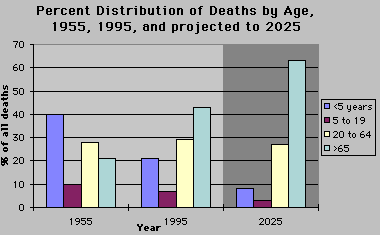| ||
|
Research for this page was done by Elizabeth Willott and Amy Boomer (an undergraduate student in Env. Ethics, 1999). I. What is the world human population? Is this number reasonable? What doubt exists with this number? Where are errors introduced? How reasonable are projections into the future? The sources below give numbers but not error ranges and they do not discuss the basis of their projections. However, by looking at data pertinent to the world population numbers, we can get an idea of what drives their predictions. Note, however, that in 1955, it would have been impossible to predict that so many women would choose (or even have the option to choose) to practise birth control successfully. Projecting from now out to 2050 has difficulties because we don't know what changes are going to happen between now and then. See part III below for some links to relevant information. Some organizations giving figures on the world population, demographics, and changes include: US Bureau of the Census; UN Population; the World Bank; and The Union of Concerned Scientists. The latter site has some explanation of the projections made by the UN.
Note that some of these are merely slightly different ways of looking at the same phenomenon. Sometimes seeing the same thing from different angles helps give a better insight. Life expectancy has been increasing: The US Census site gives the following:
People are living longer before they die
 III. Predicting the Future Thirty years ago, it would not have been reasonable to predict the dramatic decline in the Fertility Rate (number of births per woman) that has occurred virtually worldwide (for more info see Fertility Rates). Nor could anyone have predicted the incredible decrease in child mortality or increase in rate of child vaccinations. Today we do not know what will happen in Africa as a result of the HIV-AIDS crisis. Sub-Saharan Africa contains approximately 13% of the world's population but has 67% of the world's HIV-AIDS cases. Many of the cases are infants. For more information about HIV-AIDS in Africa, visit the UNAIDS HomePage at http://www.unaids.org or visit the HIV-AIDS page at this site. |
Phil 323 Hot Stuff | Web Project
